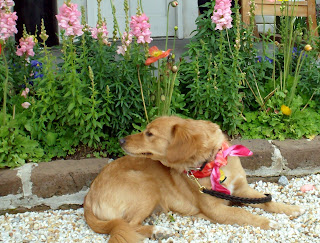Adequan belongs to a class of drugs commonly referred to as “Disease-Modifying Osteoarthritis Drugs (DMOAD). It is an FDA approved water based liquid (polysulfated glycosaminoglycan) available from and administered by a licensed veterinarian. It is an intramuscular (IM: injection into the muscle) that has been clinically shown to help treat degenerative or traumatic arthritis while giving relief from the pain due to degeneration of the joint and associated inflammation.
Adequan modifies the disease cycle as well as alleviating pain and inflammation. It stimulates the senovial lining while suppressing inflammation, thus nutrients supplied to the articular cartilage is improved. Simultaneously, Adequan blocks the excesses of degrading enzymes from affecting joint lubricant, fluid and cartilage. Adequan does not repair a poorly fitting joint, so it can't cure a hip problem, but it does aid in relieving the pain and slowing further deterioration.
Adequan is a viable option to relieve the stiffness from arthritis or joint disease. It can effectively prolong a pet's life when surgery is not an option due to age, cost considerations, non-candidate, etc.; or, by providing comfort and helping either delay or eliminate the need for surgery in some individuals. Adequan is a better choice over human OTC's (over the counter) as some human pain killers are harmful to your pet. Aspirin and Tylenol will kill your cat, aspirin will cause vomiting in some dogs, and Advil can cause severe stomach ulcers. Never use human OTC's without your vet's recommendation.
Adequan is administered in a series of eight injections over a four week period. Maximum benefits are achieved if the pet receives the full series of injections. Most pet owners begin to notice an improvement within the four week period. 70% of dogs receiving the full series show significant improvement. Lasting effects vary by individual, but I have heard of noted improvement lasting several months or more (anywhere from 6 mos. to 2 years). Brenna (my Rottie) was diagnosed with hip dysplasia at five years after showing symptoms of stiffness, difficulty getting up and refusal to jump. She was not a candidate for surgery so she took Rimadyl the rest of her days and had one full series of the Adequan injections. Before the Adequan, Brenna would whimper and cry out in pain when getting up after a nap as well as off and on during the day. After the Adequan she never again experienced that level of pain. She lived six more years. Of course her hips continued to degenerate and was her death sentence in the end, but that was due to spinal bone spurs pinching the nerves in her rear end which made her incapable of walking, not the hip joint itself.
Hip & Joint treatments should accompany careful monitoring of the dogs diet to avoid obesity which will further stress the body and increase pain/discomfort of affected joints. If your dog is already heavy at the time of diagnosis, assess and adjust his diet and intake accordingly.
Consult your veterinarian before using any other prescription or over the counter medicines including vitamins and supplements. What works for humans does not necessarily provide the same benefits for pets and can (in some cases) prove fatal.
















